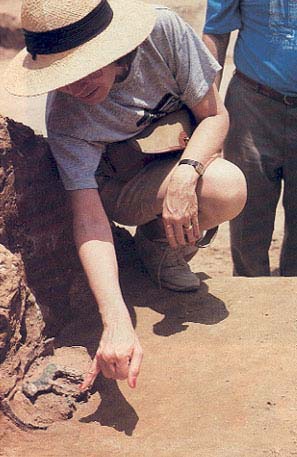Image Details

Carl Andrews, courtesy Leon Levy Expedition
First glance. Shelby White, writer and connoisseur of ancient Near Eastern art, points to a metal calf minutes after its discovery within a sanctuary at the base of Ashkelon’s north slope. The diminutive figurine (4.5 inches long and 4 inches high) electrified the excavators and became the highlight of the 1990 dig season. Lying shattered in pieces around the calf are remnants of the pottery shrine that housed the calf. The sanctuary was destroyed, together with much of the city, probably by the Egyptians in about 1550 B.C.
The calf, cast of solid bronze, was found remarkably well preserved; only the right foreleg had become detached from the rest of the body and the left horn was missing. The right foreleg and left hindleg were cast separately and riveted into the body. The remaining horn, the ears and the tail were of forged copper and were also inserted into the body. Grooves along the calf’s back and underside and around the neck still contain silver, as do parts of the legs, head and tail, leading excavators to conclude that the figurine was once completely covered by a sheet of silver.
